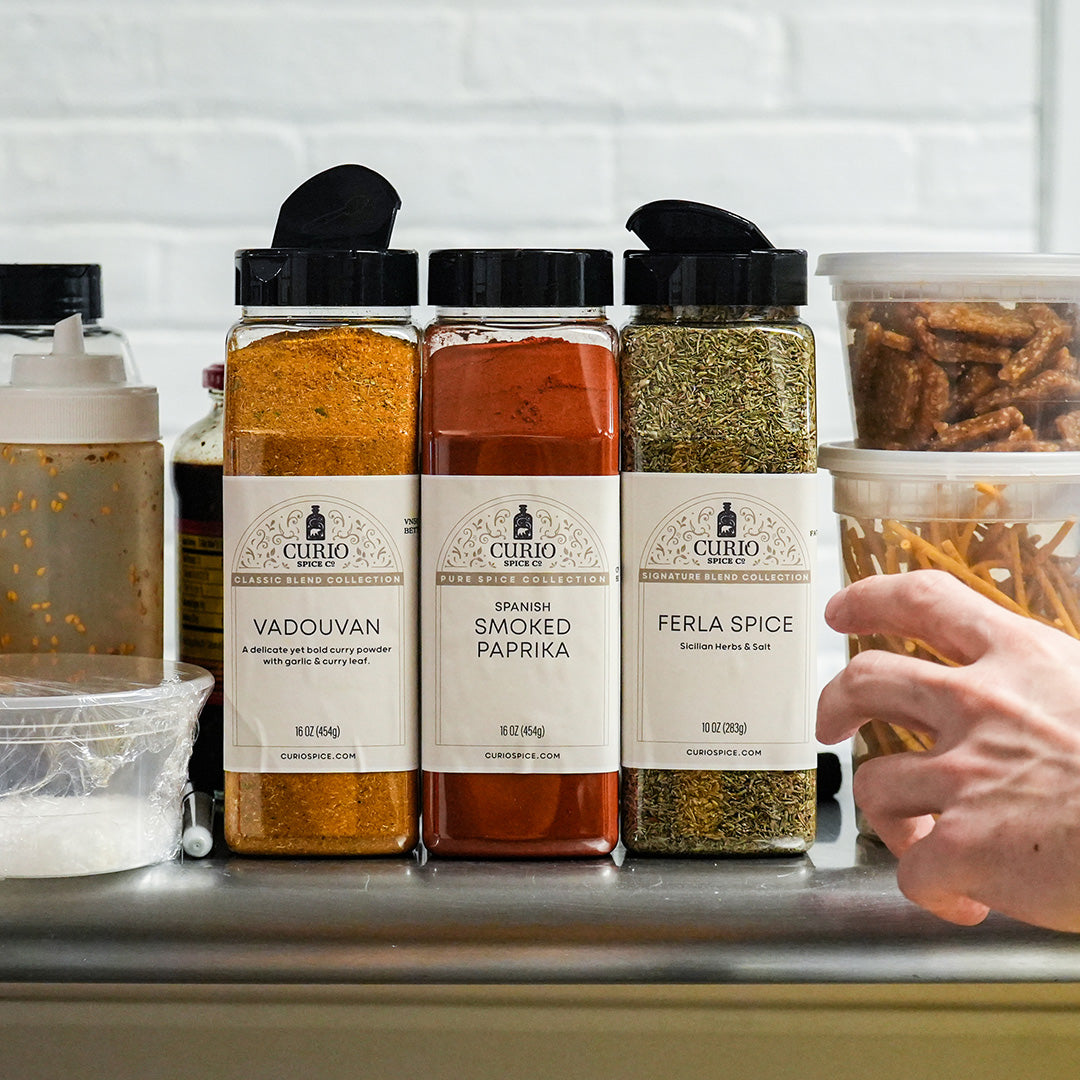A Golden Braid for Easter
Choreg—or choereg, cheoreg, or chorek, depending upon who is doing the spelling—is essentially an Armenian brioche—a butter, milk, and egg-enriched sweet bread— but with a few twists. First, it is usually formed into a three-stranded braid, not unlike many challah, or formed into individual rolls. Secondly, it is flavored with two highly-fragrant spices—nigella and malhab—that together give it an intoxicating, heady aroma. Three, it is extremely rich, even for a brioche, with a relatively high proportion of eggs, butter, and sugar. Finally, it is usually decorated with sesame or (more rarely) poppy seeds.
Maybe at this point you are thinking that choreg sounds too sweet and rich for you, or whether all that butter and sugar makes it something you’d only eat for dessert. Not so: The nigella and malhab give the bread a mysterious, complex flavor that sets it right upon the line between sweet and savory. This makes choreg a versatile, everyday bread, one that is equally at home on a breakfast table as it is served—as Armenians often do—as part of a mezze spread, alongside salty cheeses, olives, and pickled vegetables. (It also makes it excellent when used for grilled cheese sandwiches and French toast.)
Choreg is traditionally made for Easter—the three strands of the braid are meant to represent the Holy Trinity— as an indulgence after the duel abstinences of winter and lent—Armenians being both highly religious and hedonistic in equal measure—but we love this bread so much that it tends to get made year-round. Easter breads related to choreg exist elsewhere in the Eastern Mediterranean and Eastern Europe too: tsoureki, in Greece (usually flavored with mastic and/or cinnamon), paskalya çöreği, in Turkey, and paska in places like Poland, Hungary, Ukraine, and beyond.
Nigella seeds look like black sesame and are sometimes mis-labeled “black cumin,” "black caraway," or "onion seed,” since they share flavor and aroma notes with those spices, even though they are not closely related. They have a peppery, piney bite and an oregano-like aroma. They are also bitter, so they are nearly always used whole rather than ground.
Mahlab is made from the seeds of Prunus mahaleb, or the St. Lucy's cherry, a tree native to the Mediterranean, Iran, and parts of central Asia. The diminutive fruits are sour and generally only eaten by birds, but the kernels—the heart at the center of the pit—have been used by humans as a flavoring for baked goods, sweets, and cheeses since ancient times. Malhab’s flavor is aromatic and complex, drawing comparisons to cherry, almond, vanilla, and rose. (The oils in mahlab are highly susceptible to oxidation, so the seeds are best purchased whole and ground in a spice mill just prior to use, and stored in an air-tight container in the freezer.)
My choreg recipe is based upon my mother’s, but it incorporates a few modern bread baking secrets to improve its texture and longevity. As I mentioned, choreg contains a lot of sugar; one problem with high-sugar breads is that they can turn stale in a heartbeat, since the sugar pulls moisture from the crumb over time. To overcome this, I add a tangzhong, or cooked flour paste, a trick I borrow from Asian baking (tangzhong is commonly used in Japanese milk bread recipes). By precooking some of the flour and water in a dough, you can add far more water than it could handle otherwise; the extra water slows down staling to keep the choreg soft and plush for days.
 The other trick I employ is to cold-ferment the dough in the fridge for a while before shaping it. Not only does this develop additional complexity of flavor, it also makes the somewhat soft-and-sticky dough far easier to shape once cold. (I prefer the flavor of the long-fermented choreg, but if you are in a rush, you can take the dough out the fridge after just a couple of hours, once it has firmed up.)
The other trick I employ is to cold-ferment the dough in the fridge for a while before shaping it. Not only does this develop additional complexity of flavor, it also makes the somewhat soft-and-sticky dough far easier to shape once cold. (I prefer the flavor of the long-fermented choreg, but if you are in a rush, you can take the dough out the fridge after just a couple of hours, once it has firmed up.)
I have included instructions for three sizes of choreg here: one big, traditional braid, a dozen individual rolls, and two pan loaves. The last of these is not typical of choreg, but it is one I love, especially when I want to use the bread for sandwiches or toast.
Tangzhong Choreg
Makes one 750g freeform braided loaf, two 9- by 5-inch, 375g pan loaves, or twelve 65g rolls
Active time: 90 minutes
Total time: 18 hours
- Volume measurements greater than 20g are approximate; as with most bread recipes, using a scale to measure ingredients will yield the best results.
- You can use a high-protein flour like King Arthur all-purpose here, or any bread flour.
- The cold-fermentation develops flavor, but is not essential. For a quicker recipe, chill the dough for a minimum of 2 hours to firm it up for for easy shaping.
- I like to make the dough on day one, chill the dough overnight, and shape and bake the following morning.
Tangzhong
32g (3 ½ tablespoons) bread flour
97g (⅓ cup plus 1 tablespoon) boiling water
Dough
all of the tangzhong (from above)
3 large eggs (150g), cold
70g (⅓ cup) sugar
290g (2 cups plus 1 tablespoon) bread flour (see notes)
11g (4 teaspoons) nonfat milk powder
9g (2 teaspoons) instant yeast
5g (1 ½ teaspoons) whole nigella seeds
5g (1 ¼ teaspoons) mahlab kernels, ground (2 teaspoons ground)
70g (5 tablespoons) unsalted butter, cold, cut into ½-inch cubes, or grated
7g (1 ½ teaspoons) sea salt
To finish
1 large egg, beaten with a pinch of salt and 1 teaspoon water
1 tablespoon hulled sesame seeds
1 teaspoon nigella seeds
For the tangzhong paste
Place the flour in a medium bowl. Cover with the boiling water and, using a spatula or dough whisk, quickly whisk into a uniform paste with no dry flour remaining. Cover and let sit for 15 minutes.
For the dough
Whisk the eggs into the paste one at a time, making sure to create a smooth, even mixture. Add the sugar and whisk until uniform. (If necessary, blend the final mixture smooth with an immersion blender or in a blender.) Scrape into the bowl of a stand mixer.
Add the flour, yeast, milk powder, nigella, and mahlab to the mixer bowl. Set the bowl onto the mixer, and, using a dough hook, mix on low speed until just combined and no dry flour remains, 2 to 4 minutes. Cover and let sit for 20 minutes.
Add the salt and mix on low speed for 1 minute. Add the butter, and increase speed to medium and mix until the dough is no longer sticky to the touch and just starts to clear the sides of the bowl, 12 to 15 minutes.
Transfer the dough to a medium bowl, cover loosely with plastic wrap, and let sit at warm room temperature (75°F/24°C) for 45 minutes.
Using lightly-moistened hands, fold the dough over itself by gently lifting and folding the edge of the dough toward the middle. Turn the bowl 90 degrees; fold again. Turn the bowl and fold the dough 4 more times (a total of 6 turns). Cover again with plastic wrap and let sit for 45 minutes.
Repeat the folding technique, cover, and let the dough rest until risen by about half, 30 to 90 minutes. Cover tightly and refrigerate for 2 to 18 hours.

For a large choreg or two pan loaves: Turn the dough onto a clean, lightly-floured surface. Flour the top of the dough, stretch and flatten gently into a rectangle, and cut into 3 equal rectangles (about 240g each). For 9- by 5-inch pan loaves, divide the dough into 6 equal portions (about 120g each). With the long ends facing you, fold the pieces of dough over themselves 2 or 3 times to form short logs, pinching the seams closed. Cover loosely and let rest for 5 minutes.
Lightly flour the work surface. Using your hands, roll each log from the center into a 15-inch rope with slightly tapered ends. Repeat with the remaining dough logs.
Arrange the strands in parallel, with the short ends of the ropes facing you, and then gently press together the ends of the ropes farthest from you, with the center rope on top. Separate the ends of ropes closest to you in a fan shape, leaving the center rope in place. Lift the right rope over the center rope and set it to the right of the left rope. Lift the center rope and set it in the rightmost position, where the right rope was originally positioned. Lift the left rope over the now-center rope (originally the right rope) and set it in the center position. Repeat the braiding process until the ropes of dough are entirely braided, then gently press the ends together to seal. Transfer to a parchment-lined baking sheet (or two lightly-greased loaf pans), cover loosely with plastic wrap, and allow to rise at warm room temperature (75°F/24°C) until almost doubled in size, 1 ½ to 2 hours.
 For rolls: Turn the dough onto a clean, lightly-floured surface. Flour the top of dough, stretch and flatten gently into a rectangle, and cut in half lengthwise into two rectangles. Cut each rectangle crosswise into 6 equal portions (about 60g each). With the long ends facing you, fold each piece of dough over itself 2 or 3 times into a short log, pinching the seams closed. Cover loosely and let rest for 5 minutes.
For rolls: Turn the dough onto a clean, lightly-floured surface. Flour the top of dough, stretch and flatten gently into a rectangle, and cut in half lengthwise into two rectangles. Cut each rectangle crosswise into 6 equal portions (about 60g each). With the long ends facing you, fold each piece of dough over itself 2 or 3 times into a short log, pinching the seams closed. Cover loosely and let rest for 5 minutes.Using hands, roll each log from the center into a 10-inch-long rope. Form the rope into a loop, leaving 3 inches of overhang on the top end. Form into a knot by pulling overhang under the lower strand and through the center of the loop. Transfer to a parchment-lined baking sheet, arranging the rolls in a 4-by-3 pattern. Repeat with the remaining logs. Cover loosely with plastic wrap, and allow to rise at warm room temperature (75°F/24°C) until almost doubled in size, 1 ½ to 2 hours.
To Finish and Bake
Thirty minutes before baking, adjust an oven rack to the middle position and preheat the oven to 300°F (150°C). Brush the surface of the dough (loaf or rolls) with egg wash and let rest for 5 minutes. Brush again with egg wash, and sprinkle with sesame and nigella.

For a Large Choreg or pan loaves: Bake until deep golden brown and at least 200˚F/94˚C at the center, 50 to 60 minutes, rotating the baking sheet or pans halfway through baking. Transfer the baking sheet to a wire rack and let cool for 5 minutes. Using a spatula, remove the loaves from the baking sheet or pans and return to the wire rack. Let cool at least 2 hours before slicing and serving.

For Rolls: Bake until golden brown, 30 to 35 minutes, rotating the baking sheet halfway through baking. Transfer the baking sheet to a wire rack and let the rolls cool on the baking sheet at least 15 minutes before serving.
Store the cooled breads in airtight containers for best keeping.
ANDREW JANJIGIAN (aka @wordloaf) is a baking teacher, recipe developer, writer, and photographer from Cambridge, MA. Before this, he spent 11 years as a test cook at Cook’s Illustrated magazine. His IACP-award nominated bread baking newsletter can be found at wordloaf.substack.com. You can find things like past and upcoming workshops, t-shirts and sourdough starters for sale, and links to his recipes and articles on his website. Enjoy 10% off on our spices with his code "WORDLOAF" at checkout!










Hi Mel, Susan from the Curio kitchen, here. We’re very glad to hear that you enjoyed this recipe and got good results! Thanks for taking the time to let us know. We were thrilled that Andrew shared this recipe with our community -— we’re hoping that he’ll come teach a class at our Lab in 2023!
I tried the recipe and it’s really good. Thanks for the recipe. I will look into other recipes as well.
Leave a comment